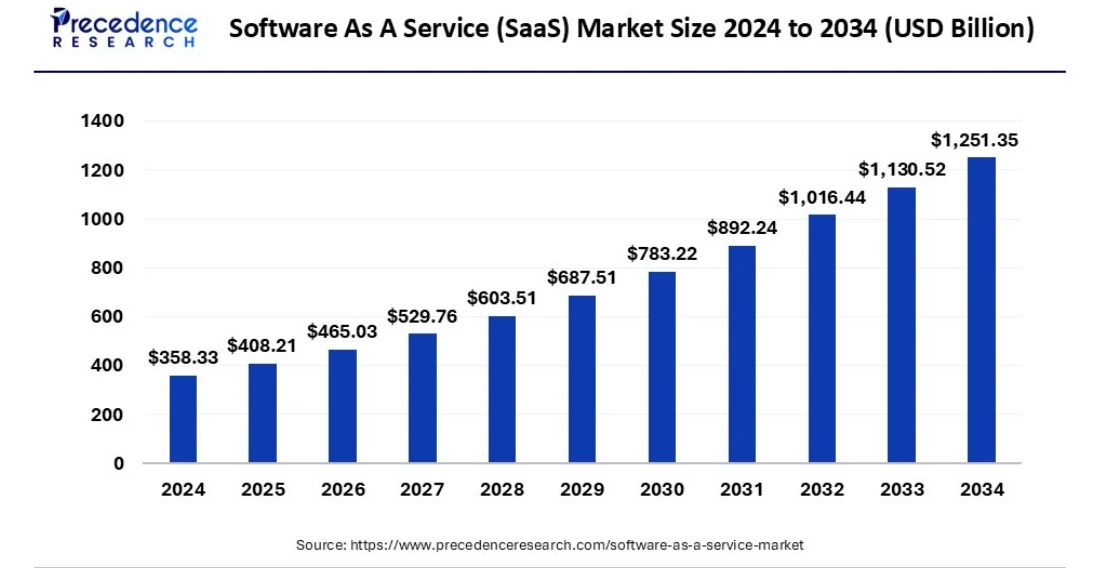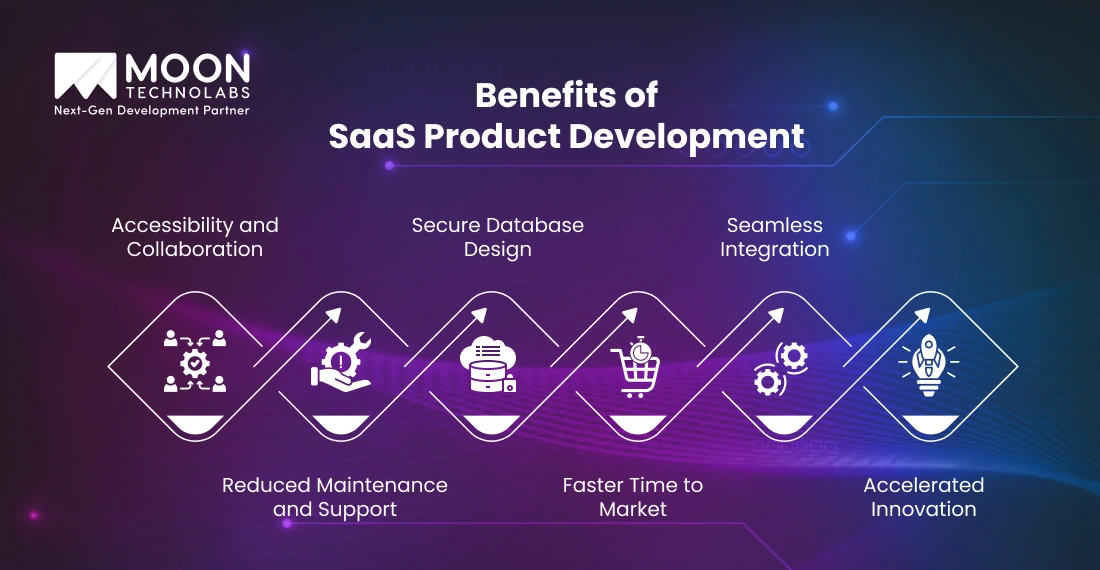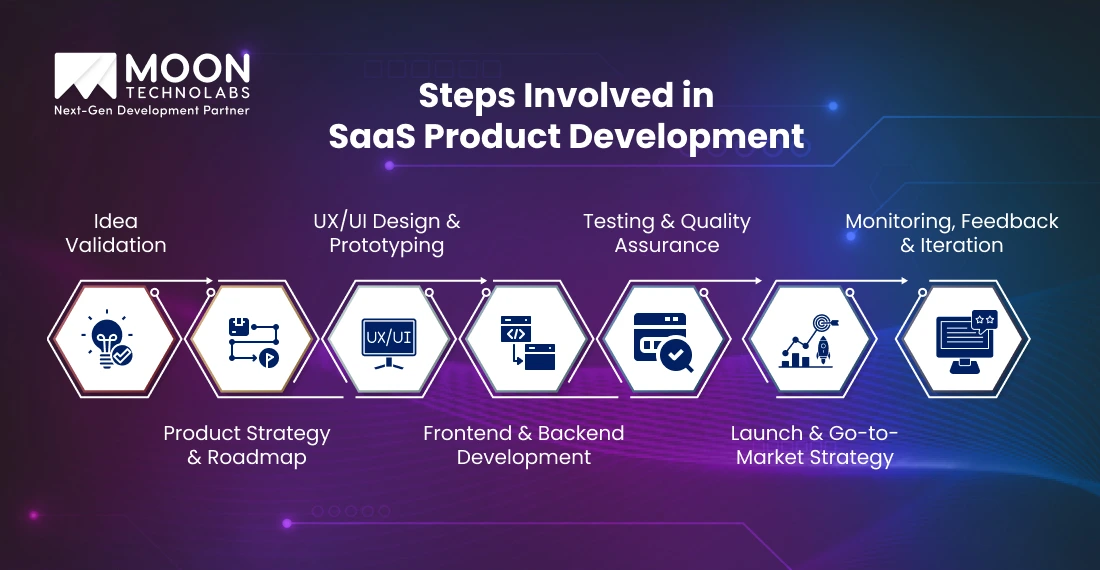Table of Content
Blog Summary:
In this post, you will delve into the details of the SaaS-based product development process and techniques to accomplish it effortlessly. We discuss each step of the development process in-depth, along with the importance and benefits of SaaS product development.
Table of Content
Software as a Service (SaaS) has revolutionized the way businesses leverage software to enhance their operations, serve customers, and fulfill other purposes. It prevents them from installing the app. They can access the app directly through browsers. The major advantage of SaaS apps is that they are cost-efficient, in addition to being user-friendly and scalable.
Due to these benefits, the demand for SaaS Product Development has surged, and most businesses now frequently opt for this approach. It has also contributed to the growth of the SaaS market. Statista predicts that the revenue in the SaaS market worldwide will be approximately $ 408.21 billion in 2025 and is expected to reach $783.22 billion by 2030.

Whether you are a large, mid-sized, or small business, opting for SaaS products can be a decisive choice. Meanwhile, planning to build a SaaS product requires a proven strategy and a clear approach. We will help you handle the development process easily by explaining every step. Let’s explore them now.
In today’s time, SaaS has gained huge popularity for providing cost-effective, scalable, and highly accessible software solutions. It minimizes the overall need for expensive infrastructure or complex installations. It enables companies to operate with higher efficiency, regardless of their location.
Whether it’s smooth updates, fast deployment, or integration with numerous other tools, SaaS supports everything. It works effectively in maximizing productivity and collaboration.
SaaS also plays a vital role in ensuring data compliance, business continuity, security, and more with reliable cloud providers. With the growth of digital transformation, SaaS has become pivotal to fostering agility, innovation, and indeed long-term growth in today’s competitive business landscape.
SaaS platform development is a process that involves creating cloud-based software. Many such companies serve users by providing these apps, which can be accessed via the internet, through a subscription-based model. The entire process encompasses multiple steps, including design, development, testing, implementation, and maintenance.
Read Complete Guide:
Users can access the end products through web browsers. SaaS products are significantly different from traditional products, as they don’t require installations or downloads. That’s why these apps are easily accessible and indeed cost-effective.
The development process also encompasses various components, including UI/UX design, market research, cloud integration, backend and frontend development, continuous updates, and more.
SaaS product development focuses on several other important factors, including performance, user experience, and data security, among others. These ensure a higher availability with vast customer satisfaction.
Get your SaaS product to market faster with a dedicated development team skilled in rapid prototyping and agile delivery.
Get to Market Faster

Organizations have increasingly adopted SaaS products to gain a competitive edge through improved operational efficiency and meet emerging customer expectations. Let’s understand some other advantages of SaaS product development:
The biggest advantage of SaaS products is that they allow users to access them from any device and location, as these apps leverage cloud platforms. The accessibility of SaaS apps maximizes smooth collaboration among clients, remote teams, investors, and others.
Whether it’s shared dashboards, real-time updates, or instant notifications, features of SaaS apps ensure everyone is on the same page. It thus boosts productivity while improving decision-making.
When it comes to traditional software, it necessitates dedicated IT teams for installation, regular updates, and maintenance. A service provider is responsible for maintaining the SaaS products, which minimize the overall burden on the internal IT resources of customers.
Whether it’s patches, automatic updates, or bug fixes, it ensures apps run seamlessly even without user intervention. It saves time and costs, while also offering an improved user experience and enhanced performance.
Security is one of the most prioritized factors in SaaS development. A reputable SaaS provider implements a robust database design and encryption protocols for securing sensitive user data.
SaaS platforms offer robust data security and compliance, including standards such as HIPAA and GDPR. SaaS providers receive regular data backups to prevent loss due to system failures or various cyber threats.
You Might Also Like:
SaaS Security Essentials: Safeguarding Your Data and Applications
Speed is something that holds great importance on the tech horizon. SaaS development enables businesses to bring their products to market faster compared to traditional software development.
Development teams leverage agile methodologies, pre-built cloud infrastructure, and reusable components to focus on key functionalities, even without working from scratch.
Another significant advantage of SaaS products is that they are easily integrated with a wide range of tools, platforms, APIs, and other technologies. These solutions are easy to configure to match any unique workflow of a business, whether it involves payment gateways, CRM systems, analytics tools, or third-party tools.
This type of interoperability even minimizes manual effort, ensuring full data consistency across various systems. It also boosts business efficiency.
Continuous innovation is a key attribute of SaaS product development. Developers gain the flexibility to gather user feedback, test new features, and roll out improvements without disrupting the entire system.
The agile approach improves a culture of experimentation and fast iteration. It helps your business stay ahead of the competition.
Read Complete Guide:

SaaS product development is a process that consists of multiple steps. Every step serves its specific purpose. Let’s explore each step in depth:
As the name suggests, idea validation involves identifying a real-world issue, understanding the target audience, and assessing market demand, among other factors. This step involves various other activities, such as competitor analysis, interviews, surveys, and MVP testing. Idea validation is necessary to minimize any risks.
A strategic plan encompasses identifying target personas, pricing models, feature sets, unique value propositions, business objectives, and other key elements. After this, professionals create a detailed roadmap followed by development milestones, timelines, and launch goals.
UI/UX design is a process that involves crafting wireframes, user flows, and high-fidelity prototypes that visually represent how the app will work. Prototyping enables teams to receive early feedback and redefine the design before development begins.
This step primarily focuses on accessibility, usability, aesthetic appeal, and other related factors. These are essential to complete a user’s journey.
The development process begins with creating technical architecture, APIs, frameworks, and other components. The front-end focuses primarily on creating user-centered components using technologies such as Angular, React, Vue.js, and others.
On the other hand, the backend is responsible for handling database management, server-side logic, user authentication, and other related tasks. Developers leverage technologies such as Python, Node.js, and Ruby to create a backend.
Thorough testing is necessary throughout the SaaS development to ensure a reliable and bug-free SaaS product. It encompasses a range of testing methods, including integration testing, unit testing, performance testing, and UI testing. QA teams enhance real-world scenarios to identify and resolve issues as early as possible.
After the completion of the development and testing process, the product is ready to launch. This step involves deploying a SaaS app on a robust cloud platform. It also involves a go-to-market (GTM) strategy. Service providers implement various marketing campaigns to lure retail users, including onboarding guides, PR, and more.
After launching, continuous monitoring is necessary to track system performance, user behavior, feature adoption, and other key metrics. Professionals leverage numerous tools to offer real-time insights, be it Mixpanel, Google Analytics, or custom dashboards. This step involves collecting user feedback through various channels, including chat, surveys, support tickets, and more.
To effectively monetize digital products, you need a great combination of strategic pricing, value-driven marketing, and smart distribution. Let’s understand various tried and tested strategies to monetize your digital products:
You Might Also Like:
With over 15 years of experience, we operate as a reliable SaaS development company. We have an expert team that specializes in creating secure, scalable, and next-generation SaaS solutions while ensuring security, scalability, and innovation.
Our SaaS developers create next-generation, tailored software solutions to meet the specific needs of your business. Whether it’s transparent communication, agile development, or post-launch support, we ensure the success of your products.
Our expert team delivers flexible, scalable SaaS solutions that grow with your business and drive long-term success.
Let’s Build Scalable SaaS
A strategic approach is necessary to develop SaaS products, in addition to continuous improvement and technical expertise. Every phase is indispensable in developing user-friendly and scalable solutions, right from project ideation to post-launch iteration.
Working with a development partner like us helps you transform your SaaS web application development ideas into robust products. It enhances user experience, drives innovation, and fosters growth.
01
02
03
04
05
Submitting the form below will ensure a prompt response from us.